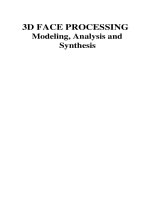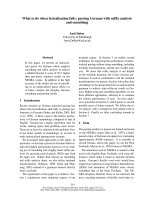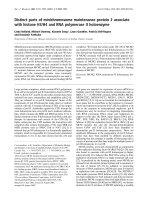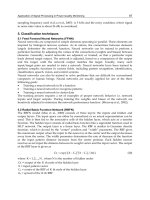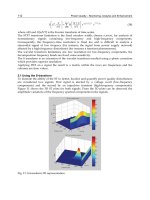Dynamics with friction modeling, analysis and experiment part II
Bạn đang xem bản rút gọn của tài liệu. Xem và tải ngay bản đầy đủ của tài liệu tại đây (12.67 MB, 329 trang )
SERIES ON STABILITY, VIBRATION AND CONTROL OF SYSTEMS
Volume 7
Series B
Dynamics with Friction
Modeling, Analysis and Experiment
Part II
Editors
Ardeshir Guran, Friedrich Pfeiffer & Karl Popp
onol .Joint
with 1
s
'""° ^ ? C
We
™
World Scientific
Dynamics with Friction
Modeling, Analysis and Experiment
Part II
SERIES ON STABILITY, VIBRATION AND CONTROL OF SYSTEMS
Series Editors: Ardeshir Guran & Daniel J. Inman
About the Series
Rapid developments in system dynamics and control, areas related to many other
topics in applied mathematics, call for comprehensive presentations of current
topics. This series contains textbooks, monographs, treatises, conference proceedings and a collection of thematically organized research or pedagogical articles
addressing dynamical systems and control.
The material is ideal for a general scientific and engineering readership, and is
also mathematically precise enough to be a useful reference for research specialists
in mechanics and control, nonlinear dynamics, and in applied mathematics and
physics.
Selected
Volumes in Series B
Proceedings of the First International Congress on Dynamics and Control of Systems,
Chateau Laurier, Ottawa, Canada, 5-7 August 1999
Editors: A. Guran, S. Biswas, L Cacetta, C. Robach, K. Teo, and T. Vincent
Selected Topics in Structronics and Mechatronic Systems
Editors: A. Belyayev and A. Guran
Selected Volumes in Series A
Vol. 1
Stability Theory of Elastic Rods
Author: T. Atanackovic
Vol. 2
Stability of Gyroscopic Systems
Authors: A. Guran, A. Bajaj, Y. Ishida, G. D'Eleuterio, N. Perkins,
and C. Pierre
Vol. 3
Vibration Analysis of Plates by the Superposition Method
Author: Daniel J. Gorman
Vol. 4
Asymptotic Methods in Buckling Theory of Elastic Shells
Authors: P. E. Tovstik and A. L. Smirinov
Vol. 5
Generalized Point Models in Structural Mechanics
Author: I. V. Andronov
Vol. 6
Mathematical Problems of the Control Theory
Author: G. A. Leonov
Vol. 7
Vibrational Mechanics: Theory and Applications to the Problems of
Nonlinear Dynamics
Author: llya I. Blekhmam
SERIES ON STABILITY, VIBRATION AND CONTROL OF SYSTEMS
< < ^ ^ > Series B
Volume 7
Series Editors: Ardeshir Guran & Daniel J Inman
Dynamics with Friction
Modeling, Analysis and Experiment
Part II
Editors
Ardeshir Guran
Institute of Structronics, Canada
Friedrich Pfeiffer
Technical University of Munich, Germany
Karl Popp
University of Hannover, Germany
V f e World Scientific
wW
Singapore •»New
New Jersey
• London • Hong Kong
Jersey'London*
Published by
World Scientific Publishing Co. Pte. Ltd.
P O Box 128, Farrer Road, Singapore 912805
USA office: Suite IB, 1060 Main Street, River Edge, NJ 07661
UK office: 57 Shelton Street, Covent Garden, London WC2H 9HE
British Library Cataloguing-in-Publication Data
A catalogue record for this book is available from the British Library.
DYNAMICS WITH FRICTION: MODELING, ANALYSIS AND EXPERIMENT, PART II
Copyright © 2001 by World Scientific Publishing Co. Pte. Ltd.
All rights reserved. This book, or parts thereof, may not be reproduced in any form or by any means,
electronic or mechanical, including photocopying, recording or any information storage and retrieval
system now known or to be invented, without written permission from the Publisher.
For photocopying of material in this volume, please pay a copying fee through the Copyright Clearance
Center, Inc., 222 Rosewood Drive, Danvers, MA 01923, USA. In this case permission to photocopy is
not required from the publisher.
ISBN 981-02-2954-2
Printed in Singapore by Uto-Print
STABILITY, VIBRATION
AND
CONTROL OF SYSTEMS
Editor-in-chief: Ardeshir Guran
Co-editor:
Daniel J. Inman
Advisorj ' Board
Henry Abarbanel
University of California
San Diego
USA
Lucia Faravelli
Universita di Pavia
Pavia
ITALY
Gerard Maze
University of Le Havre
Le Havre
FRANCE
Jon Juel Thomsen
Tech. Univ. of Denmark
Lyngby
DENMARK
Gary L. Anderson
Army Research Office
Research Triangle Park
USA
Toshio Fukuda
Nagoya University
Nagoya
JAPAN
Hans Natke
Universitat Hannover
Hannover
GERMANY
Horn-Sen Tzou
University of Kentucky
Lexington
USA
Jorge Angeles
McGill University
Montreal
CANADA
Hans Irschik
Johannes Kepler Universitat
Linz
AUSTRIA
Sotorios Natsiavas
Aristotle University
Thessaloniki
GREECE
Firdaus Lid wad ia
University of S. California
Los Angeles
USA
Teodor Atanackovic
University of Novi Sad
Novi Sad
FED REP OF YUGOSLAVIA
Heikki Isomaki
Helsinki Univ. of Tech.
Helsinki
FINLAND
Paul Newton
University of S. California
Los Angeles
USA
Dick van Campen
University of Technology
Eindhoven
NETHERLANDS
Anil Bajaj
Purdue University
Lafayette
USA
Jer-nan Juang
Langley Research Center
Hampton
USA
Michihiro Natori
Inst, of Space & Astro.
Kanagwa
JAPAN
Jorg Wauer
Technische Universitat
Karlsruhe
GERMANY
Anders Bostrom
Chalmers Technical Univ.
Goteborg
SWEDEN
John Junkins
Texas A&M University
College Station
USA
Friedrich Pfeiffer
Technische Universitat
Munchen
GERMANY
Joanne Wegner
University of Victoria
Victoria
CANADA
Rafael Carbo-Fite
C.S.I.C.
Madrid
SPAIN
Youdan Kim
Seoul National University
Seoul
SOUTH KOREA
Raymond Plaut
Virginia Poly. Inst.
Blacksburg
USA
James Yao
Texas A&M University
College Station
USA
Fabio Casciati
Universitat di Pavia
Pavia
ITALY
Edwin Kreuzer
Technische Universitat
Hamburg-Harburg
GERMANY
Karl Popp
Universitat Hannover
Hannover
GERMANY
Lotfi Zadeh
University of California
Berkeley
USA
Marc Deschamps
Laboratoire de Mecanique
Bordeaux
FRANCE
Oswald Leroy
Catholic University of
Louvain
BELGIUM
Richard Rand
Cornell University
Ithaca
USA
Franz Ziegler
Technische Universitat
Wien
AUSTRIA
Juri Engelbrecht
Estonian Academy of Sci.
Tallin
ESTONIA
Jerrold Marsden
California Inst, of Tech.
Pasadena
USA
Kazimirez Sobczyk
Polish Academy of Sci.
Warsaw
POLAND
Professor Ilya Blekhman (left) and Professor Andeshir Guran (right) during the
International Symposium on Mechatronics & Complex Dynamical Systems,
June 2000, St. Petersburg, Russia.
In Memoriam
Heinrich Hertz (1857-1894)
Paul Painleve (1863-1933)
Arnold Sommerfeld (1868-1951)
Preface
The pictures on the front cover of this book depict four examples of mechanical systems with
friction: i) dynamic model of normal motion for Hertzian contact, ii) disk with a rotating
mass-spring-damper system, iii) planar slider-crank mechanism, iv) dynamic model of a
periodic structure. These examples, amongst many other examples of dynamical friction
models, are studied in the present volume.
Historically, the exploitation of dynamical friction has had a tremendous effect on human
development. In fact, due to the human desire to describe nature, machines, and structures,
ideas about friction and dissipation has found their way into scientific thoughts. The science
of mechanics is so basic and familiar that its existence is often overlooked. Whenever we
push open a door, pick up an object, walk or stand still, our bodies are under the constant
influence of various forces. When the laws of the science of mechanics are learned and applied
in theory and practice, we achieve an understanding which is impossible without recognition
of this subject. Today still we agree with what da Vinci wrote in fifteen century, mechanics
is the noblest and above all others the most useful, seeing that by means of it all animated
bodies which have movement perform all their actions. The science of mechanics deals with
motion of material bodies. A material body may represent vehicles, such as cars, airplanes
and boats, or astronomical objects, such as stars or planets. For sure such objects will
sometimes collide or contact each other (cars more often than stars). One may think of a
walking human or animal making frictional contact with the ground, sports such as golf and
baseball, where contact produces spin and speed, and mechanical engineering applications,
such as the parts of a car engine that must contact each other to transfer force and power.
The sub-field of mechanics that deals with contacting bodies is simply referred to as contact
mechanics. It is a part of the broader area of solid and structural mechanics and an almost
indispensable one since forces are almost always applied by means of frictional contacts.
Contact mechanics has an old tradition: laws of friction, that are central to the subject,
were given by Amontons in 1699, and by Coulomb in 1785, and early mathematical studies
of friction were conducted by the great mathematician Leonhard Euler. A theory for contact
between elastic bodies, that has had a tremendous importance in mechanical engineering,
was presented by Heinrich Hertz in 1881. Contact mechanics has seen a revival in recent
years, driven by new computer resources and such applications as robotics, human artificial
joints, virtual reality, animation, and crashworthiness.
Contact mechanics is the science behind tribology, the interdisciplinary study of friction,
wear and lubrication, with major applications such as bearings and brakes, and involving
such issues as microscopic surface geometry, chemical conditions, and thermal conditions.
Note that while in many tribological applications one seeks to minimize friction to reduce
loss of energy, everyday life is at the same time impossible without friction — we would not
be able to walk, stand up, or do anything without it. Walking requires adequate friction
between the sole of the foot and the floor, so that the foot will not slip forward or backward
and the effect of limb extension can be imparted to the trunk. Lack of friction on icy
surfaces is compensated for by hobnails on boots or chains on tires. Friction is necessary
to operation of a self-propelled vehicle, not only to start it and keep it going but to stop
it as well. Crutches and canes are stable due to friction between their tips and the floor;
this is often increased by a rubber tip which has a high coefficient of friction with the floor.
A wheel-chair can be pushed only because of the friction developed between the pusher's
shoes and the floor, and friction must likewise be developed between the wheels and the
floor so they will turn and not slide. Many friction devices are used in exercise equipment
IX
x
Preface
to grade resistance to movement, as with a shoulder wheel or stationary bicycle. Brakes on
wheelchairs and locks on bed casters utilize the principle of friction. Application of cervical
or lumbar traction on a bed patient depends on adequate opposing frictional forces developed
between the patient's body and the bed. In the operation of machines, sliding friction and
damping wastes energy. This energy is transformed into heat which may have a harmful
effect on the machine, as with burned-out bearings. To reduce friction, materials having a
very smooth or polished surface are used for contacting parts, or a lubricant, such as oil or
grease, is placed between the moving parts. Frictional effects are then absorbed between
layers of the lubricant rather than by the surfaces in contact. Friction also exists within the
human body. Normally ample lubrication is present as tendons slide within synovial sheaths
at sites of wear, and the articulating surfaces of joints are bathed in synovial fluid.
Despite this tremendous importance of contact mechanics and frictional phenomena, we
still hardly understand it. The present part II of this volume on Dynamics with Friction is a
continuation of the previous part I, and is designed to help synthesize our current knowledge
regarding the role of friction in mechanical and structural systems as well as everyday life.
We understand that in the preface of the first part in this book we promised the readers to
have a final review chapter with a complete list of references in friction dynamics. However,
we soon realized that the knowledge in this field in written form is expanding very rapidly
at a considerable rate which makes a comprehensive list almost impossible. The present
volume offers the reader only a sampling of exciting research areas in this fast-growing field.
In compilation of the present volume, we also noticed, relatively very little is made available
in this field to design engineers, in college courses, in handbooks, or in form of design
algorithms, because the subject is too complicated. For an expository introduction to the
field of dry friction with historical notes we refer the readers to the article by Brian Feeny,
Ardeshir Guran, Nicolas Hinrichs, and Karl Popp, published recently in Applied Mechanics
Review, volume 51, no. 5 in May 1998, and the list of references at the end of that article.
Every year there are several conferences in this field. Those of longest standing are the
conferences of ASME, STLE, IUTAM, and EUROMECH. A separate bi-annual conference,
held in U.S., is the Gordon conference in tribology. It is a week-long conference held in
June, at which about 30 talks are given. Another separate biannual conference, held in
even-numbered years, is the ISIFSM (International Symposium on Impact and Friction of
Solids, Structures, and Intelligent Machines: Theory and Applications in Engineering and
Science). The proceedings of ISIFSM papers are rigorously reviewed and appeared in volumes
published in this series.
Today, research continues vigorously in the description and design of systems with friction models, in quest to understand nature, machines, structures, transportation systems,
and other processes. We hope this book will be of use to educators, engineers, rheologists,
material scientists, mathematicians, physicists, and practitioners interested in this fascinating field.
Ardeshir Guran
Ottawa, Canada
Friedrich Pfeiffer
Munich, Germany
Karl Popp
Hannover, Germany
Contributors
M. A. Davies
National Institute of Standards
and Technology
Manufacturing Engineering Laboratory
Gaithersburg, MD 20899
USA
B. F. Feeny
Department of Mechanical Engineering
Michigan State University
East Lansing, M l 48824
USA
Aldo A. Ferri
G. W. Woodruff School of Mechanical
Engineering
Georgia Institute of Technology
Atlanta, GA 30332-0404
USA
Ardeshir Guran
American Structronics and Avionics
16661 Ventura Blvd
Encino, California 91436
USA
Daniel P. Hess
Department of Mechanical Engineering
University of South Florida
Tampa, Florida 33620
USA
R. V. Kappagantu
Altair Engineering, Inc.
1755 Fairlane Drive
Allen Park, M l 48101
USA
Francesco Mainardi
Department of Physics
University of Bologna
46 Via Irnerio, Bologna 40126
Italy
Dan B. Marghitu
Department of Mechanical Engineering
Auburn University
Auburn, Alabama 36849
USA
J. P. Meijaard
Laboratory for Engineering Mechanics
Delft University of Technology
Mekelweg 2, NL-2628 CD Delft
The Netherlands
F. C. Moon
Department Mechanical and
Aerospace Engineering
Cornell University
Ithaca, NY 14853
USA
John E. Mottershead
Department of Mechanical Engineering
The University of Liverpool
Livepool, L69 3BX
UK
G. L. Ostiguy
Department of Mechanical Engineering
Ecole Polytechnique
P. O. B. 6079, Succ. "Centre-Ville"
Montreal (Quebec), H3C 3A7
Canada
Contents
Preface
Ardeshir
ix
Guran, Friedrich Pfeiffer and Karl Popp
Contributors
xi
DYNAMICS WITH FRICTION: MODELING, ANALYSIS
E X P E R I M E N T S , P A R T II
AND
C h a p t e r 1: I n t e r a c t i o n of V i b r a t i o n a n d Friction at D r y Sliding C o n t a c t s
Daniel P. Hess
1
1. Introduction
1
2. Normal Vibration and Friction at Hertzian Contacts
3
3. Normal Vibration and Friction at Rough Planar Contacts
7
4. Normal and Angular Vibrations at Rough Planar Contacts
9
5. Stability Analysis
13
6. Chaotic Vibration and Friction
20
7. Conclusions
25
8. References
26
C h a p t e r 2: V i b r a t i o n s and Friction-Induced Instability in D i s c s
John E. Mottershead
29
1. Introduction
29
2. Disc Vibrations and Critical Speeds
2.1 Flexural vibrations
2.2 Vibration of a spinning membrane
2.3 Combined effects of centrifugal and flexural rigidity
2.4 Travelling waves and critical speeds
2.5 Imperfect discs
30
30
32
33
34
36
3. Excitation by a Transverse-Spring-Damper System
3.1 Stationary disc with a rotating mass-spring-damper system
3.2 Rotating disc with a stationary mass-spring-damper system
3.3 Instability mechanisms
39
40
45
46
4. Follower Force Friction Models
4.1 Follower force analysis in brake design
4.2 Sensitivity analysis
4.3 Distributed frictional load
4.4 Friction with a negative /z-velocity characteristic
48
48
49
50
51
5. Friction-Induced Parametric Resonances
52
xiii
xiv
Contents
5.1 Discrete transverse load
5.1.1 Simulated example
5.2 Distributed load system
5.2.1 Simulated example
6. Parametric Excitation by a Prictional Follower Force with a
Negative fi-Velocity Characteristic
6.1 Simulated example
53
57
59
63
66
70
7. Closure
70
Acknowledgment
73
References
73
C h a p t e r 3: D y n a m i c s of Flexible Links in K i n e m a t i c C h a i n s
Dan B. Marghitu and Ardeshir Guran
75
1. Introduction
75
2. Kinematics and Kinetics of Flexible Bodies in General Motion
2.1 Small deformations
2.2 Large deformations
77
77
80
3. Equations of Motion for Small Deformations in Rectilinear Elastic Links 81
4. Equations of Motion for Large Deformations in Rectilinear Elastic Links
4.1 Planar equations of motion
5. The Dynamics of Viscoelastic Links
5.1 Application
5.2 Computing algorithm
6. The Vibrations of a Flexible Link with a Lubricated Slider Joint
6.1
6.2
6.3
6.4
Reynolds equation of lubrication
Cavitation
Solution method for an elastic link in a rigid mechanism
Application to a slider mechanism
7. References
C h a p t e r 4: Solitons, C h a o s a n d M o d a l Interactions in P e r i o d i c S t r u c t u r e s
M. A. Davies and F. C. Moon
83
84
85
86
89
89
89
91
92
94
97
99
1. Introduction
99
2. Experiment
102
3. Numerical Model
103
4. Forced Vibrations and Modal Interactions
108
4.1 Numerical experiment — Modal trading
4.2 Forced vibrations of the experimental structure
108
110
Contents
xv
5. Impact Response
5.1 Comparison of experiment and model
5.2 Calculation of nonlinear wave speeds
115
115
119
6. Conclusions
120
7. Acknowledgments
122
8. References
122
C h a p t e r 5: A n a l y s i s and M o d e l i n g of a n E x p e r i m e n t a l Frictionally
Excited Beam
R. V. Kappagantu and B. F. Feeny
125
1. Introduction
125
2. Experimental Setup
126
3. Friction Measurement
128
4. Displacement Measurement
133
4.1 From strain to displacement
133
5. Dynamical Responses
135
6. Proper Orthogonal Modes
138
7. Mathematical Model
141
8. Numerical Simulations and Validation
143
9. Discussion and Elaboration
147
10. Conclusions
150
11. Acknowledgments
151
References
151
C h a p t e r 6: Transient W a v e s in Linear V i s c o e l a s t i c M e d i a
Francesco Mainardi
Introduction
155
155
1. Statement of the Problem by Laplace Transform
156
2. The Structure of Wave Equations in the Space-Time Domain
159
3. The Complex Index of Refraction: Dispersion and Attenuation
162
4. The Signal Velocity and the Saddle-Point Approximation
167
5. The Regular Wave-Front Expansion
172
6. The Singular Wave-Front Expansion
178
Conclusions
186
Acknowledgments
186
References
186
xvi
Contents
C h a p t e r 7: D y n a m i c Stability and N o n l i n e a r P a r a m e t r i c V i b r a t i o n s
of R e c t a n g u l a r P l a t e s
G. L. Ostiguy
191
1. Introduction
191
2. Theoretical Analysis
2.1 Analytical model
2.2 Basic equations
2.3 Boundary conditions
2.4 Method of solution
194
194
195
195
197
3. Solution of the Temporal Equations of Motion
199
4. Stationary Response
4.1 Principal parametric resonances
4.2 Simultaneous resonances
4.3 Combination resonances
199
201
202
203
5. Nonstationary Responses
204
6. Results and Discussion
205
Acknowledgments
222
References
223
C h a p t e r 8: Friction M o d e l l i n g a n d D y n a m i c C o m p u t a t i o n
J. P. Meijaard
1. Introduction
2. Phenomenological Models
2.1
2.2
2.3
2.4
Models without memory effects
Models with memory effects
Stability of stationary sliding
Two-dimensional sliding
3. Analysis of Systems of Several Rigid Bodies
3.1 Analysis of mechanical systems
3.2 Arch loaded by a horizontal base motion
3.3 Four-bar linkage under gravity loading
References
C h a p t e r 9: D a m p i n g t h r o u g h U s e of P a s s i v e and S e m i - A c t i v e D r y
Friction Forces
Aldo A. Ferri
227
227
229
230
235
236
240
240
240
244
247
250
253
1. Introduction
253
2. Passive Mechanisms
254
Contents
2.1
2.2
2.3
2.4
2.5
Background
Linear-Coulomb damping
Profiled block
Shock and vibration isolation
In-plane slip
3. Semi-Active Friction
3.1
3.2
3.3
3.4
Semi-active damping
Semi-active friction damping in a SDOF system
Structural vibration control
Semi-active automative suspension
4. Conclusions
xvii
254
256
265
269
273
280
281
282
283
295
297
5. Acknowledgment
298
6. References
298
Subject Index
309
Author Index
313
Dynamics with Friction: Modeling, Analysis and Experiment, Part II, pp. 1-27
edited by A. Guran, F. Pfeiffer and K. Popp
Series on Stability, Vibration and Control of Systems, Series B, Vol. 7
© World Scientific Publishing Company
INTERACTION OF VIBRATION A N D FRICTION
A T DRY SLIDING CONTACTS
DANIEL P. HESS
Department of Mechanical
Engineering
University of South Florida
Tampa, Florida 33620, USA
ABSTRACT
When measuring or modeling friction under vibratory conditions, one should ask
how contact vibrations are influenced by the presence of different types of
friction or one should seek to determine the extent to which vibrations can alter
the mechanisms of friction itself. This paper summarizes results from the
author's work on dry sliding contacts in the presence of vibration. A number of
idealized models of smooth and rough contacts are examined, in which the
assumed sliding conditions, the kinematic constraints, and the mechanism of
friction are well-defined. Instantaneous and average normal and frictional forces
are computed. The results are compared with experiments. It appears t h a t
when contacts are in continuous sliding, quasi-static friction models can be used
to describe friction behavior, even during large, high-frequency fluctuations in
the normal load. However, the dynamics of typical sliding contacts, with their
inherently nonlinear stiffness characteristics, can be quite complex, even when
the sliding system is very simple.
1. Introduction
Surfaces in contact are often subjected to dynamic loads and associated
contact vibrations. The dynamic loading may be generated either external to the
contact region, as in the case of unbalanced moving machinery components, or
within the contact region, as in the case of surface roughness-induced vibration.
Vibrations may be undesirable from the point of view of the stresses that are
induced or noise that is generated and may need to be controlled. Furthermore,
vibrations can affect friction and the outcome of friction measurements.
In this paper, an overview of the author's work on dry friction in the presence
of contact vibrations is given. The reader is referred to other papers 1 7 for
details. Some general observations will be made regarding the interaction of
friction and vibration and the interpretation of friction coefficients under
vibratory conditions.
The models discussed are limited to continuous sliding, although extensions
to loss of contact or sticking could be made. The models accommodate forced
2
D. P. Hess
contact vibrations of a rigid rider mass, supported by smooth Hertzian or
randomly rough planar compliant contacts undergoing elastic deformation.
Initially the rider is constrained to move only along a line normal to the sliding
direction. The vibration problem is solved for the normal motions. To allow a
well-defined mechanism of friction to be explicitly inserted into the dynamic
model, the instantaneous friction force is related to the normal motion through
the adhesion theory of friction. Accordingly, the instantaneous friction force is
taken to be proportional to the instantaneous real area of contact. While we
recognize the limitations of the adhesion theory, it is selected due to its
simplicity and its ability to describe many situations of practical interest 8 .
A general feature of the results is that as the normal oscillations increase, the
average separation of the surfaces increases. This is due to the nonlinear
character of the contact stiffness which increases (hardens) as the instantaneous
normal load increases from its mean value and decreases (softens) as the load is
reduced. This increase in average separation is, under the assumptions stated
above, sometimes, but not always, accompanied by a decrease in the average
friction force.
A more interesting, yet still simple, model is that of a rough block in planar
contact that is allowed to translate and rotate with respect to the countersurface
against which it slides. We have developed a modification of the GreenwoodWilliamson 9 rough surface model for this purpose. The basic equations are given
and general features of the problem are discussed. Some comparisons are made
with experiments and with part of the work of Martins et al.10, in which a
similar problem using a phenomenological constitutive contact model is
examined.
Before proceeding, we comment on the interpretation of the coefficient of
friction under dynamic conditions. If both the load and the friction force at a
contact vary with time, the instantaneous friction coefficient, |i(r), is
,»-
%
Of particular interest is the interpretation of average friction.
One
interpretation of average friction is to take the time average of [i(t), denoted by
(n(f)). Alternatively, one could define an average friction coefficient, n^,, as the
average friction force divided by the average normal load, so that
V. = < ^ >
(2)
If the normal load remains constant or the instantaneous friction coefficient does
not change with time, the two interpretations are equivalent. Otherwise they
are not.
This is readily demonstrated by considering the example of a smooth,
massless, circular Hertzian contact to which an oscillating load PB (1 + cosQf) is
1. Interaction
of Vibration and Friction at Dry Sliding Contacts
3
applied. This amount of load fluctuation is just enough to give impending
contact loss at one extreme of the motion. The friction coefficient is \i0 when
the load is at its mean value, Pg. For illustration purposes, the instantaneous
friction force is assumed to be proportional to the instantaneous real area of
contact. It is easy to show1 that, in this case, — = 0.92 whereas ^ = 1.84. This
is illustrated in Fig. 1. The time average of the friction coefficient, (n(0),
increases while the average friction force decreases. When F, P and [i all vary
with time, the coefficient of friction seems to be of limited value. Particular
difficulties arise when P{t)~0. For defining average friction, the definition of
Eq. (2) is preferred.
Sometimes, in friction testing, only the instantaneous friction force is
measured. Even this requires a measurement system with sufficient frequency
bandwidth to accurately measure the fluctuating forces. The normal load is not
monitored. If one incorrectly assumes that the normal load remains constant,
when it does not, one obtains an "apparent friction" coefficient which can be
quite different from the actual friction. Apparent friction sometimes includes
stick or loss of contact which do not represent friction in the usual sense.
2. Normal Vibration and Friction at Hertzian Contacts
As the first and simplest example, the dynamic behavior of a circular Hertzian
contact under dynamic excitation is examined. The system is shown in Fig. 2.
The rider has mass, m, and is in contact with a flat surface through a
nonlinear stiffness and a viscous damper. The lower flat surface moves from left
to right at a constant speed, V. The friction force, F, acts on the rider in the
direction of sliding. The rider is constrained to motion normal to the direction
of sliding. The model accommodates the primary normal contact resonance. The
contact is loaded by its weight, mg, and by an external load, P = i*a(1 + aCOSQf),
which includes both a mean and a simple harmonic component. The normal
displacement, y, of the mass is measured upward from its static equilibrium
position, y0. The equation of motion during contact, obtained from summing
forces on the mass is
my + cy - / ( 8 ) = -/>„(1 +aCOSQf) - mg
for 8 > 0
where 8 is the contact deflection and /(8) is the restoring force given by
/(8) = !£'*U=Kl(y0-y)2
,
y0-[^^f
(3)
(4)
4 D. P. Hess
0.0
0.2
Figure 1. Instantaneous and average load, area, and friction (force and coefficient) for a smooth
massless Hertzian contact.
1. Interaction
of Vibration and Friction at Dry Sliding Contacts
5
Figure 2. Dynamic model of normal motion for Hertzian contact.
An approximate steady-state solution to this nonlinear system has been obtained 1
using the perturbation technique known as the method of multiple scales.
The contact area, A, is proportional to the contact deflection, (y 0 -y). Based
on the adhesion theory of friction, the instantaneous friction force is assumed to
be proportional to the area of the contact. Therefore,
(5)
The normal oscillations, y(t), are asymmetrical due to the nonlinear contact
stiffness, and give rise to a decrease in average contact deflection, (y0- (y)), (i.e.,
an increase in separation of the sliding bodies) by an amount (y), where (y) is
the average of y(t). Since Eq. (5) is linear, we can also write
(6)
6
D. P. Hess
i
3
2
11
10-i
(
no applied vibration
M
freq. (Hz)
3
•
*
2
10-2
J_L
1 01
20
100
1000
I
I
2
3
I I Mill
I
2
1 02
3
I I II
103
Accel, (in/s2)
Figure 3. Measurements from Godrey (1967) showing the effect of vibration on friction;
^ ^ ^ ^ ^ ^ _ , present theory.
As oscillations increase, the average contact area, and, by implication, the
average friction are reduced. A reduction in average friction force of up to ten
percent was shown to occur1 prior to loss of contact. This is not greatly different
from the result obtained without considering inertia forces or damping and
illustrated in Fig. 1.
Godfrey11 conducted experiments to determine the effect of normal vibration
on friction. His apparatus consisted of three steel balls fixed to a block that slid
along a steel beam and was loaded by the weight of the block. The beam was
vibrated by a speaker coil at various frequencies. The normal acceleration of the
rider and the friction at the interface were measured. His measurements, under
dry contact conditions, are illustrated in Fig. 3. If one assumes that occasional
contact loss begins to occur when the normal acceleration reaches an amplitude
of one g, one can superimpose the friction reduction predicted by our model as
indicated by the heavy line. Reasonably good agreement is obtained. At higher
